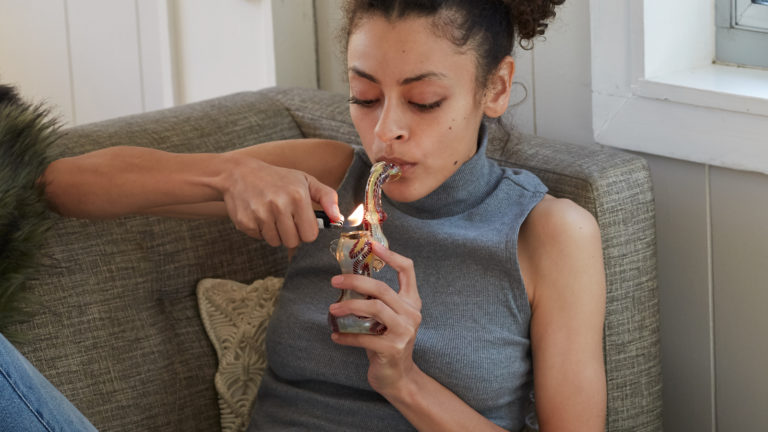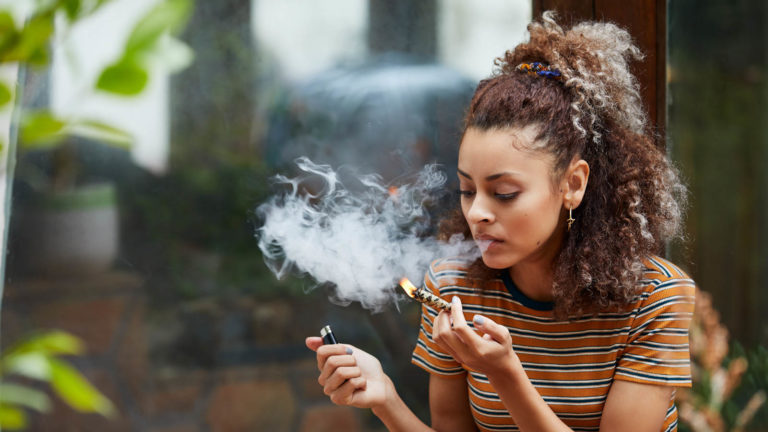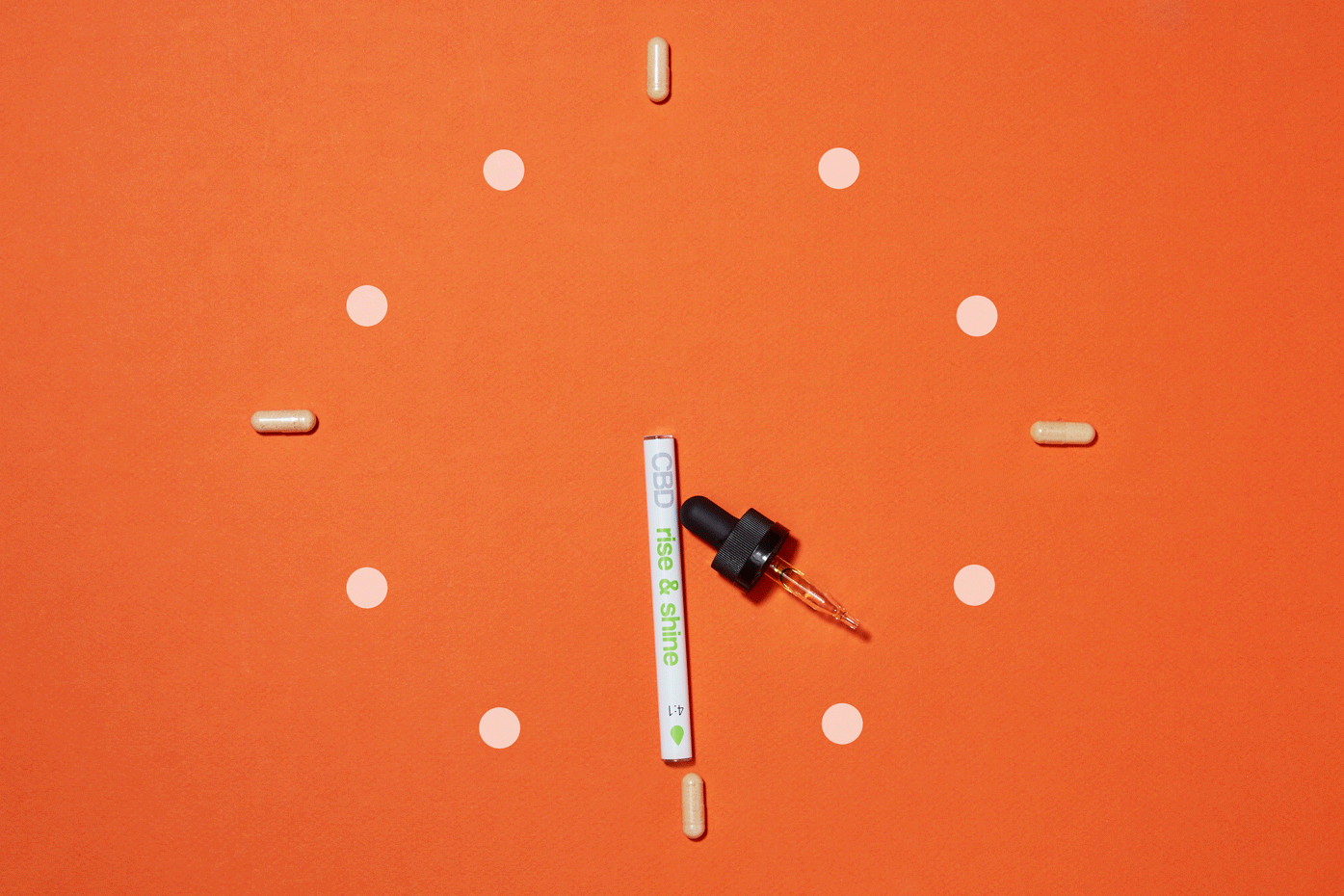In recent years, cannabidiol (CBD) oil has skyrocketed in popularity. Knowledge about how it works in the human body, however, has accelerated at a snail's pace. If you've ever wondered, “How long does it take for CBD oil to work?” or “How long will the effects of CBD oil last?” you're not alone.
In this article, we'll answer these questions and cover how different consumption methods will alter your CBD experience.
How does CBD interact with the body?
CBD interacts with the brain and body through a number of mechanisms. Upon ingestion, CBD interacts with a wide range of proteins in the body and central nervous system. A key part of this interaction takes place within the endocannabinoid system (ECS) — specifically the CB1 and CB2 cannabinoid receptors.
 Photo by: Gina Coleman/Weedmaps
Photo by: Gina Coleman/WeedmapsImage lightbox

CBD also interacts with other receptor proteins not directly related to the ECS, such as the serotonin receptor 5-HT1A and vanilloid receptor TRPV1. Any potential anti-inflammatory and pain-relieving properties of CBD could stem from the activation of these additional biological pathways.
Bottom line: The relationship between CBD and the human body is complicated. The method of consumption, the quality of the CBD product, and individual body chemistry all determine how this cannabinoid moves through your body and how long it takes to leave your system.
The method of consumption matters
The method of consumption plays a critical role in how long it will take to feel the effects of CBD. CBD is available in many different forms, and each has an influence on the onset time, among other factors.
Ingestion
The most common method for CBD consumption involves administering a couple of drops directly into the mouth. Swallowing the oil will prevent the CBD from immediately entering your bloodstream, sending it instead through the digestive tract and eventually on to the liver, where it is broken down before finally reaching the bloodstream.
Studies show that when CBD compounds are metabolized by the liver, it undergoes what is called the “first pass effect,” where enzymes in the liver reduce CBD concentration before the remainder is finally sent to the bloodstream and circulated throughout the body.
When ingesting CBD edibles, the same principle applies. Let's say, for example, you're taking CBD gummies or adding a few drops of CBD oil into your favorite recipe. It will ultimately go through the same lengthy process and reduce the total CBD concentration in your bloodstream. With ingestion, it could be one to two hours before the effects of CBD finally set in.
Bottom line: Ingesting CBD via a tincture or a CBD oil-infused edible will result in a longer onset (up to two hours) and possibly weaker effects.
Sublingual
You can consume CBD oil sublingually by placing a few drops of CBD under your tongue and rubbing it into the tissue there with your tongue or finger for at least 30 seconds to a minute before swallowing. This will allow the mucous membranes in your mouth to absorb the CBD, partially bypassing the digestive system and liver, for much quicker entry into the bloodstream. Effects may be felt within seconds. Just like when you ingest THC edibles though, you'll get a second onset of effects a couple of hours later when the CBD that wasn't absorbed sublingually makes it through your digestive system.
 Photo by: Gina Coleman/Weedmaps
Photo by: Gina Coleman/WeedmapsImage lightbox

Bottom line: Expect to feel the effects of sublingual administration within 30 minutes. Any effects you feel should last an hour or more but be bolstered at about two hours.
Inhalation
Whether you're smoking a high-CBD strain, puffing on a hemp flower pre-roll, or taking a draw from a CBD vape pen, inhalation is often seen as an effective method of delivery for CBD because of how quickly it's absorbed in the body. When you smoke CBD flower or vape CBD oil, cannabinoids go directly to your lungs where they rapidly enter your bloodstream and circulate throughout your body. CBD reaches peak concentrations within three minutes after consumption, meaning the effects can be felt shortly after use.
 Photo by: Gina Coleman/Weedmaps
Photo by: Gina Coleman/WeedmapsImage lightbox

Bottom line: Smoking CBD flower or vaping CBD oil is one of the fastest ways to experience the effects of CBD. Any effects you feel will set in almost immediately and last roughly an hour or slightly longer.
Transdermal
When it comes to easy, effective CBD dosing, transdermal patches have a lot going for them. Based on the same principles as nicotine or birth control patches, CBD patches deliver a long-lasting dose very efficiently. The cannabinoid readily diffuses into our skin, through our skin cells, and into the bloodstream, especially when it's helped along by permeation enhancers. Patches can help with localized skin and muscle issues but they are right up there with smoking when it comes to getting as much of the CBD you consume into your bloodstream as possible. It's also a discreet option that delivers a steady dose over hours.
 Photo by: Shutterstock
Photo by: ShutterstockImage lightbox

Bottom line: Using a transdermal CBD patch is an efficient, effective way to enjoy the cannabinoid's effects, which set in within an hour and last for several hours, depending on the patch's formulation.
Topical
When you apply topical CBD products directly to your skin, the CBD is absorbed and slowly interacts with localized cannabinoid receptors. In some cases, CBD-infused topicals should be applied liberally to overcome the low cannabinoid absorption rate of the skin. With topical application, any CBD effects you feel will peak after about 90 minutes. This method of administration is often used for chronic pain in specific areas.
 Photo by: Gina Coleman/Weedmaps
Photo by: Gina Coleman/WeedmapsImage lightbox

Bottom line: Applying CBD oil topically isn't likely to have a profound effect, but it may help address mild discomfort in specific areas of your body.
Dosage matters
The way CBD interacts with and leaves your body depends on several factors that vary from person to person.
Bodyweight
Body fat influences the amount of CBD you need to feel an effect. The larger the body mass, the more CBD required to feel potential effects. Bodyweight and mass also affect how long CBD will remain in your system. Like THC, CBD is stored in fat cells and gradually eliminated from the body through urine and feces.
Metabolism
The metabolic rate of the individual also has some sway over how long CBD stays in the system. The body's metabolism determines the time needed to break down and synthesize compounds, which affects how long it takes the body to process and metabolize the cannabinoid.
 Photo by: Gina Coleman/Weedmaps
Photo by: Gina Coleman/WeedmapsImage lightbox

Frequency of use
It's not just your body that influences how long it takes CBD to work, but also the quality of the CBD product and how often it's used. Once you acquire CBD oil, the next step is to find the optimal dosing regimen, including frequency of use. The answers will depend largely on the type of product, amount of CBD inside it, and the specific ailment you are targeting. Most reputable manufacturers will provide instructions on how to properly use the product, but experimentation may be required to find the optimal dose for you and your specific needs.
CBD dosage
Settling on the ideal CBD dosage is an important part of the treatment process, and will also impact how long CBD stays in your system. Hemp-derived CBD products are not intended to give the user a stoned buzz or intoxicated feeling, so there's no need to be conservative with the dosage amount. Still, it's recommended to start with a lower dosage and gradually increase it until the ideal effects are discovered.
If you're brand new to CBD, start with a few puffs of a smokeable product, 1 milliliter of oil or tincture, or 10 milligrams of CBD if you're consuming an edible product. Wait to see how you respond before consuming more.
How long does it take CBD to get out of your system?
We've covered the factors that determine how long it takes for CBD to work, but what about how long it takes to get CBD out of your system? Again, it depends on many of the aforementioned factors that determine the effectiveness of the cannabinoid itself.
 Photo by: Gina Coleman/Weedmaps
Photo by: Gina Coleman/WeedmapsImage lightbox

A 2018 review of existing CBD studies found that the estimated half-life of CBD was two to five days for those who took a daily oral dose. Other delivery methods delivered varied half-lives. Since you may feel the effects of CBD immediately after inhalation, this method is appealing for those seeking immediate, potential pain relief. The same study found that the half-life of smoked CBD was 31 hours.
How CBD affects drug test results
Some people may be apprehensive to try CBD over concerns that it could cause them to fail a drug test. It's highly unlikely that CBD would show up on most drug screenings, as most tests specifically look for the presence of THC and THC metabolites. But even hemp-derived CBD can contain trace amounts of THC, so there's technically a chance — albeit extremely slim — of receiving a false-positive test result from taking an unusually large dose of CBD oil (estimates range from 1,000 to 2,000 milligrams per day).
For those worried about THC showing up in their system, look for broad-spectrum oil or products that contain pure CBD isolate. Broad-spectrum oil, as opposed to full-spectrum oil, is refined to exclude the trace amounts of THC that may have been present in the hemp plant. Products with CBD isolate contain no THC or other plant-based cannabinoids. To find high-quality CBD, search for products that come with a certificate of analysis from a third-party testing lab to ensure that the information listed on the product label is accurate. Be careful not to confuse hemp seed oil or hemp oil, which seldom contain any CBD at all, with CBD oil. These products will provide a hearty dose of omega-3 fatty acids, but they won't provide any potential pain-relieving or anti-anxiety effects.
Frequently asked questions
How long does it take for CBD oil to work orally?
Consuming CBD oil via sublingual administration will deliver any effects within 30 minutes. CBD edibles have the longest onset time, and it may take two hours to feel any effects.
How soon does CBD oil work for anxiety?
It depends on how you consume it. For the quickest potential anxiety relief, smoke high-CBD hemp flower, vape a CBD oil vape, or administer CBD sublingually, taking care to rub it in.
Does CBD oil actually do anything?
That depends on the person, the quality of the CBD oil, and the consumption method. If you've used a CBD product in the past and it did nothing, check whether it came from a licensed brand or retailer that performs third-party lab tests. If this is the case, the dosage might be at play. Unlike THC and most other cannabis products, CBD is non-intoxicating and you can experiment with large increases in your dose with little risk. If you take any prescription medication, be sure to check with your doctor or pharmacist before trying CBD in any form.
How long does it take for CBD oil to work for pain relief?
If you're using a topical product for potential localized pain relief, it could take anywhere from a few minutes to an hour to feel a difference. Again, buy products from licensed brands and retailers that perform third-party lab tests to ensure you're getting a legitimate product.
Major contributions from Dr. Adie Rae.

